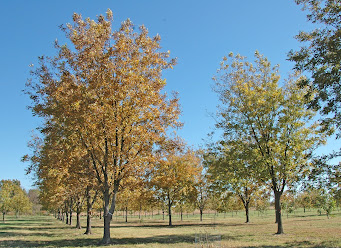One-year-old pecan seedlings are generally not very impressive (photo at right). The seedling's priority is to grow a strong tap root to ensure its survival as a young trees during challenging weather conditions. During the early years of tree establishment, top growth is suppressed in favor massive root growth. Only after the tree has created a large, healthy root system, will top growth take off.
Once planted in the field, a small pecan seedling is easy to overlook but not so for deer. Years ago, I had several seedling trees pulled out of the ground and chomped by a passing deer. It seems they like the taste of well fertilized seedling pecan trees. So before I leave the planting site I always cage each tree.
The first step is to drive a steel fence post into the ground about 12 to 14 inches from the seedling (photo at right). Note that the paddle on the fence post is still showing above the ground. I do this intentionally to prevent tree roots from growing over the paddle and making fence post removal difficult.
Once the fence post has been driven, I place a welded wire cage around the seedling (photo at left). At this point, such a large cage seems like overkill but the cage will remain in place for many years or until the tree has been grafted and grown above the height of the cage.
In the short term, the tree cage makes finding young seedling trees planted out in a large field much easier. The cage not only helps me locate each tree but gives me a good idea of how large a weed-free area I need to maintain to stimulate tree growth.









